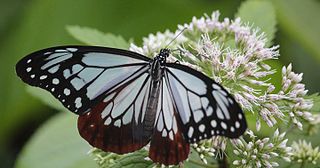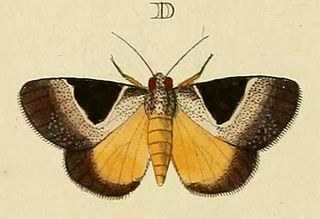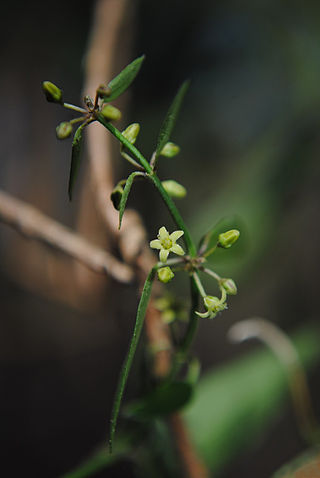
The Asclepiadoideae are a subfamily of plants in the family Apocynaceae. Formerly, they were treated as a separate family under the name Asclepiadaceae, e.g. by APG II, and known as the milkweed family.

Parantica sita, the chestnut tiger, is a butterfly found in Asia that belongs to the crows and tigers, that is, the danaid group of the brush-footed butterflies family.

Pergularia is a genus of the botanical family Apocynaceae. Pergularia daemia is a perennial twinning herb that grows along the roadsides of India and tropical and subtropical regions in South Asia, Africa, and Australia.

Holostemma is a genus of flowering plants in the family Apocynaceae. The genus was first described in 1810. As presently constituted, the genus contains only one known species, Holostemma ada-kodien, native to southern Asia.

Vincetoxicum rossicum is a flowering plant in the family Apocynaceae. It is a perennial herb native to southern Europe and is a highly invasive plant growing in all of the Eastern United States, in the mid west, and southern Ontario and Quebec in Canada. It has several common names including swallowwort, pale swallowwort, and dog-strangling vine. There has historically been much confusion about the genus it belongs to, with authors placing it within Vincetoxicum and others within Cynanchum, but recent molecular and chemical analyses have shown it to belong in the genus Vincetoxicum.

Metastelma is a genus of plant in the family Apocynaceae first described in 1810.

Sarcostemma is a formerly recognized genus of flowering plants in the dogbane family, Apocynaceae, first described as a genus in 1810. The name is derived from the Greek words σαρκὸς (sarkos), meaning "flesh," and στέμμα (stemma), meaning "garland". Members of the genus were known generally as climbing milkweeds or caustic bushes. The genus Sarcostemma has been shown to be nested within the genus Cynanchum, and in 2012 Sarcostemma was put into synonymy with Cynanchum.
Tylophora is a former genus of climbing plants or vines, first described as a genus in 1810. The genus was originally erected by Robert Brown for four species he described in Australia. It was synonymized with Vincetoxicum in 2018, a decision accepted by Plants of the World Online as of February 2023.

Thevetia is a genus of flowering plants in the family Apocynaceae, first described for modern science as a genus in 1758. It is native to Mexico, Central America, South America, and Cuba. The taxonomy of the genus is controversial, with some authors including Cascabela within Thevetia, while others accept the two genera as separate.

Imperata is a small but widespread genus of tropical and subtropical grasses, commonly known as satintails.

Gymnema is a genus in the family Apocynaceae first described as a genus in 1810.

Periploca is a genus of plants in the family Apocynaceae, first described for modern science by Linnaeus in 1753. It is native to Europe, Asia, and Africa.
- Periploca aphyllaDecne. - Middle East from Sinai to Pakistan
- Periploca calophylla(Wight) Falc. - S China, Nepal, Bhutan, Assam, E Himalayas, Vietnam
- Periploca chevalieriBrowicz - Cape Verde Islands
- Periploca chrysanthaD.S. Yao, X.D. Chen & J.W. Ren - Gansu Province in China
- Periploca floribundaTsiang - Yunnan, Vietnam
- Periploca forrestiiSchltr. - Guangxi, Guizhou, Qinghai, Sichuan, Tibet, Yunnan, India, Kashmir, Myanmar, Nepal
- Periploca graecaL. - Mediterranean
- Periploca hydaspidisFalc. - Kashmir
- Periploca laevigataAiton - Canary Islands, Savage Islands
- Periploca linearifoliaQuart.-Dill. & A. Rich - Ethiopia
- Periploca nigrescensAfzel. - W Africa
- Periploca refractifoliaGilli - Tanzania
- Periploca sepiumBunge - widespread across much of China
- Periploca tsiangiiD. Fang & H.Z. Ling - Guangxi Province in China
- Periploca visciformis(Vatke) K. Schum. - Somalia

Dichromia sagitta is a moth of the family Erebidae first described by Johan Christian Fabricius in 1775. It is found in India, Macau, Hong Kong, Japan and Taiwan.
Tweedia is a genus of flowering plants in the family Apocynaceae, first described as a genus in 1835. The genus is native to South America. An ornamental plant, Oxypetalum coeruleum, formerly included in this genus is commonly referred to as "tweedia".
- Tweedia andina(Phil.) G.H.Rua - Chile
- Tweedia aucaensisG.H. Rua - Argentina
- Tweedia australis(Malme) C. Ezcurra - Argentina
- Tweedia birostrata(Hook. & Arn.) Hook. & Arn. - Chile
- Tweedia brunonisHook. & Arn. - Argentina, Bolivia, Paraguay
- Tweedia echegarayi(Hieron.) Malme - Argentina
- Tweedia solanoides(Hook. & Arn.) Chittenden - Argentina, Brazil, Paraguay, Uruguay

Orthosia is a genus of plants in the family Apocynaceae, first described as a genus in 1844.
Telminostelma is a genus of plants in the Apocynaceae, first described as a genus in 1885. It is native to Brazil and Bolivia in South America.
- Telminostelma foetidum(Cav.) Fontella & E.A.Schwarz - Chuquisaca region in Bolivia
- Telminostelma roulinioidesE. Fourn. - Brazil
- Telminostelma carautanum, syn of Cynanchum carautanum
- Telminostelma corymbosum, syn of Cynanchum blandum
- Telminostelma ekmanii, syn of Cynanchum caudiculatum
Jobinia is a genus of flowering plants of the family Apocynaceae first described in 1885. It is native to South America and Central America.
Seutera is a genus of plants in the family Apocynaceae, first described as a genus in 1828. The name went unused until revived in 2006. It is native to Mexico, the West Indies, and the southeastern United States.
Funastrum angustifolium is a plant species. Commonly known as the Gulf coast swallow-wort, it is a perennial dicot that grows in the southern United States as far west as Texas. It is in the Cynanchum genus and Apocynaceae family. A flowering vine, it produces white blossoms with greenish and yellow parts. A member of the milkweed family, it is a plant host for monarch butterflies and produces wind dispersed seed pods.

Vincetoxicum bracteatum, synonyms including Tylophora pauciflora, is a species of climbing plant in the family Apocynaceae. It is commonly known as kiri aguna in Sri Lanka. It is edible and is used in traditional medicine. It was first described by Carl Peter Thunberg in 1821 as Cynanchum bracteatum.














